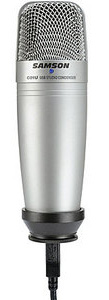What is a Mic Preamp?

The term preamp, most often paired with the word microphone is something you’ll see a lot if you do much reading about audio recording.
So what is a preamp? Well first off, it’s short for “preamplifier.” Second, yes – it is a thing that amplifies something before it goes to an amplifier. I know, I know – more confusing terminology in the audio recording world. Shocker. That’s one of the reasons I write these articles.
OK, so what are they talking about when they say “microphone preamplifier” or “mic pre” for short?
Here it is. Microphones put out really quiet levels. But audio recorders (and other devices that ultimately amplify and send signals to speakers) need something a called a line level, which is quite a bit louder than mic level. So you need a device to boost (amplify) a microphone level to line level. And that device is called…you guessed it…a preamplifier.
Anything you can plug a microphone into (well, that EXPECTS to have a mic plugged into it – I guess technically you could plug one into your ear) will have a mic preamp built in. A computer sound card, for example, has a little hole with the word mic written write next to it.
There will be a preamp in there somewhere. Likewise, most mixers have microphone inputs which have preamps in them. But neither of the above examples of preamps are ideal for recording.
To keep cost down, mixer manufacturers use inexpensive preamps since there are a bunch of them on board. Built-in sound cards on computers are also very cheap since most folks aren’t using them to record pro quality audio.
So if we are going to record great sounding audio with our computers, we need good mic preamps. Most audio interface units these days only have 1 or 2 mic preamps built in (such as with the Focusrite Scarlett 2i2 interface), which has two), and that is what you are mainly paying for.
They are much quieter and cleaner than the ones in mixers or computers, which is why they sound so much better. Oh, and something else handy to know is that USB mics (like the Samson C01U) have preamps built right into them.
So that’s my answer to the question “what is a mic preamp?” You didn’t want to know much more than that did you? Well, if you do, you can do the bonus reading below. I asked someone to give me 400 words on what a preamp was and I got what I asked for; a technical and academic sounding description. But hey, some folks may be interested so to you I say “read on!”
Cheers!
Ken
Extra credit reading on preamps
A broadly used term in the world of audio is the word “preamp”. Defined, a preamp is an amplifier that prepares electrical signals for increased amplification prior to them being received by the main amplifier. By design a preamp is supposed to do one or a combination of the following functions: increase the gain or the amount the signal level, convert unbalanced levels to balanced, change the tone, and/or lower output impedance.
Essentially the preamp works to make sure that there is an effective relationship between input and output so that the power it takes to receive and produce a sound isn’t compromised. Without going too deep into the technical explanations of each of the before mentioned uses of a preamp, one could say that the preamp is a multifaceted audio device.
When speaking of preamps it’s often discussed in relation to a separate power amp. The preamp is the signal processing component of an amplifier. Traditionally, the way you got better sound quality was to separate the two sections of the amplifier. Separating the preamp from the power amp redesigns your power supply so it is capable of managing electronics of more complex or sensitive signals without the interference from a nosier amplifier. In most cases when discussing preamps, users tend to mean amplifiers that are separate from the power amp. This would require a detached power amp to power speakers. An amplifier with both sections in it is called an integrated amplifier or just a plain old amp.
The versatility of a preamp as an audio tool shapes the sounds of an amplified microphone or instrument. The preamp usually includes dials that act as tone controls that adjust low, mid and high frequencies. The dials allow users to increase or decrease bass and treble as they see fit. Once the signal is processed the user now has the tone and sound they desired.
Preamplifiers may be found incorporated into home audio systems where the term takes on additional definitions. Most often, home audio preamps simply mean the device that switches between altered line level sources. In this sense no true amplification takes place; however the preamp does supply voltage to the amp. This is enough voltage to power loud speakers although it doesn’t register as a significant current gain.
Preamps can also be found implanted in other pieces of equipment like turntables, microphones and electric/bass guitars.



Thanks for this! You’ve given answers to my wondering mind! Such a great help for me!
No problem!